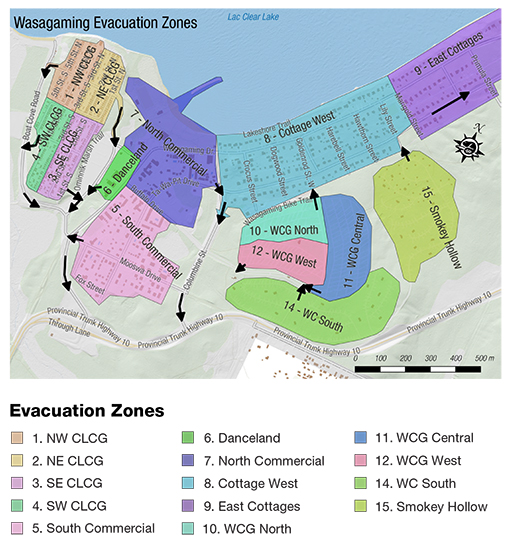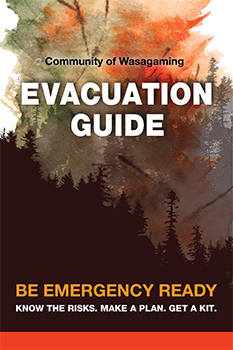
Evacuation guide
Riding Mountain National Park
In an emergency, it’s easy to become confused or panicked. Preparing your emergency plan and emergency kit in advance will help you keep focused and able to act quickly when an evacuation is necessary.
Stay informed
Visit getprepared.ca and https://www.gov.mb.ca/emo/preparedness/prepare.html for more information and resources.
Know the risks
In the event of a significant emergency, first responders will be busy responding to the emergency. You should be ready to look after yourself and your family for at least 72 hours.
Your ability to be self-sufficient will free up resources to assist those in need.
Make a plan
Get together with your family and loved ones and work on your emergency plan together. Make sure everyone understands what would happen and what to do in the event of a major emergency.
Fill out the evacuation plan on the next page with your family. Once completed, photocopy or take a picture of the plan, and keep a copy in your emergency kit. Everyone should have access to this important information in case you get separated. Remember that cell phones and internet might be down during an emergency.
Visit getprepared.ca and click on “make a plan” and then “make your family emergency plan online” for a more detailed emergency plan template.
If you need help getting out of your home, cottage or cabin, work with family or friends to make a plan.
Get a kit
Put together an emergency kit and keep it somewhere easy to get if you have to evacuate. Keep your kit in a backpack, suitcase or tub, and keep it light enough to be able to lift it into your car. Make sure you keep enough gas in your tank to make it out of town at all times.
Items to take at the last minute
- Wallet: identification, credit cards and cash
- Cell phone and charger
- Glasses and contacts
- Medications
- Car keys
Items to put in your emergency kit
- Six litres of water per person (include small bottles)
- Extra set of car keys
- Copy of your emergency plan, including emergency contact numbers
- First aid kit
- Prescription record from your pharmacist, as needed
- Flashlights for each family member
- Three-day supply of nonperishable food per person (replace once a year)
- Battery-powered radio and extra batteries, or wind-up radio
- Change of clothing including extra warm clothing (hat, mittens)
- Copies of important documents (birth certificates, passports, insurance, and bank records)
- Pet food and water
Additional supplies to consider
- Candles and matches or lighter
- Activities for children like books or toys
- Toiletries and personal hygiene items
- Basic tools and duct tape
- Hand sanitizer, toilet paper and garbage bags
- Small fuel-operated stove and fuel
- Other camping supplies
If time allows, consider packing family photos and other irreplaceable items, personal computer, information on hard drives, laptop(s) and charge cord(s), and easily carried valuables.
Evacuations
You will be informed of potential evacuations as early as possible. You must take the initiative to stay informed and aware. Evacuation routes, timing and affected areas will change depending on the situation. Evacuation zones may be specified, but in the event of a large wildfire, a community-wide evacuation is more likely to happen.
Keep a full tank of gas in your vehicle at all times and have an emergency kit ready to go.
When an emergency does strike, go early for your own safety and to avoid getting caught in fire, smoke, or road congestion.
If an emergency is in progress but no evacuation is required, information updates will be provided. If you have to evacuate, make a plan to go to a family or friend who live outside of Wasagaming.
During an evacuation, a reception centre will be set up to help people who have nowhere to go. The location of the reception centre will be included in emergency notifications.
When possible in an emergency situation emergency notifications will be broadcast through the national Alert Ready Emergency Alert System which is managed in this province by the Manitoba Emergency Measures Organization.
Parks Canada will issue two kinds of notices. Know the difference!
EVACUATION ALERT
An Evacuation Alert tells people to prepare for an evacuation. If you are ready to go and can evacuate early, please do so.
EVACUATION ORDER
An Evacuation Order tells people to evacuate immediately. This may happen in circumstances where there is little or no time to notify, or following an Evacuation Alert.
How to evacuate
- Wasagaming has been divided into several evacuation zones. Know which zone you are in and which zone you work in. First responders will use these zones to identify which parts of Wasagaming must be evacuated. Evacuation zones may be specified, but during a large wildfire, a community-wide evacuation is more likely to happen.
- If you need transportation, go to the assembly point closest to your home or workplace. Dress for the weather and bring your emergency kit. Keep in mind that you may not be able to return to your home.
- If you have a vehicle and can take a passenger, stop by an assembly point on your way out. Parks Canada will organize transportation for people who are gathered at the assembly points.
Community of Wasagaming EVACUATION ZONES

BE EMERGENCY READY
KNOW THE RISKS. MAKE A PLAN. GET A KIT.
![]() Download an Evacuation Guide (PDF 5 MB)
Download an Evacuation Guide (PDF 5 MB)
Keep this guide in your emergency kit or in a place where it can be found easily by everyone in your household.
Related links
- Important bulletins
- Top tips to respect wildlife and stay safe
- AdventureSmart
- Activities on frozen water bodies
- Automated External Defibrillator (AED) locations
- Winter Visitor Safety
- Ticks and Lyme disease
- The Do’s and Don’ts of Photographing Wildlife
- Poison ivy
- Swimmer's itch
- Use of drones at Parks Canada places
- Weather
- Road conditions
- Date modified :
